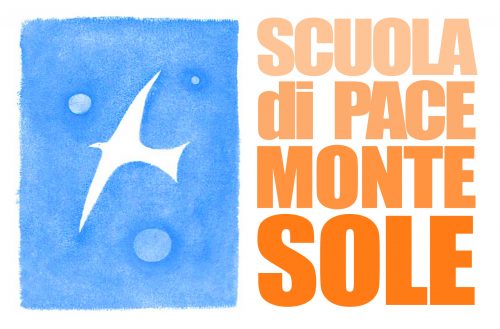The Monte Sole Historical Park
The Monte Sole Historical Park was created on the territory where Nazis murdered hundreds of people, especially civilians, during the World War II, annihilating the local Red Star partisan brigade and exterminating the community that they had lived there for centuries.
Arriving in Monte Sole
Monte Sole is a triangle of hills between the valley of the stream Setta and the river Reno. The way it looks today is just a pale trace of what used to be there at the beginning of the Second World War, where houses and little villages were spread all around.
The silence and the peacefulness of this seemingly untouched place is the result of a terrible violence, a violence that is testified by, by the ruins one can find there, a sign of an extreme violation of human rights.
The entrance of the Monte Sole Peace School.
Monte Sole is a triangle of hills between the valley of the river Setta and the river Reno. The way it looks today is just a pale trace of what used to be there at the end of the Second World War, where houses and little villages were spread all around.
The silence and the peacefulness of this seemingly untouched place is the result of a terrible violence, a violence that is testified by, by the ruins one can find there, a sign of what happened during the Second World War.
Between the lines
During WWII the Monte Sole area was inhabited by around 2000 people, who lived in small villages and isolated houses.
The Gothic Line, representing the Nazis’ defensive rearguard, cut through Italy close by.
A partisan brigade called Stella Rossa (Red Star), founded in October 1943 mostly by local inhabitants of different political and cultural backgrounds, was active in the area. The brigade was comprised of Catholics, communists, liberals and socialists, all of whom wished to put an end to Fascism the war and the German occupation. The brigade undertook manoeuvres intended to disrupt both the Nazi presence and the Nazi retreat.
In the summer of 1944 the 16th SS Panzergrenadier ‘Reichsführer’Division of Waffen-SS, led by Max Simon, was deployed in the area. It engaged in a military operation to comb ‘enemy territory’ and destroy the partisan groups.
The partisan activities in the area were regarded as dangerous because they threatened Nazi supply centres, communication and retreat lines, and were branded as ‘bandit activities’ by the Nazi army.
In the early morning of September 29th 1944, the four companies of the reconnaissance battalion (Aufklaerungs abteilung) of the division under the command of SS-Sturmbannführer (Major) Walter Reder left from the Setta Valley heading for various places where partisans were suspected to be. Other units were also placed in the Reno Valley to circle and comb the area.
The whole procedure was perfectly compliant with the theories of the Nazi army on counterinsurgency activities, which had been developed and strengthened on the European Eastern Front.
The Nazi manoeuvre achieved the desired result; within hours the partisans were depleted and rendered impotent, with many of them escaping from the area during the night.
The operation was repeated in the same way from September 29th to October 5th.
The casualties were almost all Italian civilians: only seven Nazi soldiers were killed, whereas around 20 partisans were killed, taken prisoner or injured. The Nazis burned down houses and killed animals as part of their actions, which culminated in a massacre of 770 people in seven days, among which 216 children, 142 elderly people and 316 women. The behaviour of each platoon and squad was the same: mass killings took place simultaneously in places sometimes very far from each other, where civilians were killed indiscriminately, often with grenades, and corpses were burned so as to make it look like death by bombing. The operation affected 115 different places: villages, churches, isolated farms and houses.
The Monte Sole massacres had been planned in advance and they were not merely a reaction to the partisan resistance, which, from a military point of view, was actually quite weak and isolated. Therefore, those massacres cannot be considered a reprisal, but a reconnaissance operation of deliberate slaughter. It was perfectly compliant with the wider strategy of the Nazi army in Italy, aimed at terrorising the population (and thereby preventing any sort of resistance) and dispersing existing resistance groups.
No distinction was made between civilians and so-called bandits: the whole population was deemed supportive of the partisans. Such an attitude is a consequence of the contempt instilled in the Nazi troops for the partisans, whom they considered bandits and Bolsheviks, and for the communities within which the partisans operated. Each unit implemented the orders according to the criteria of its own commander, and the 16th SS Division was certainly one of the strictest operating on the Italian front.
The operation was very effective from a Nazi point of view.
The area, its inhabitants and, with them, any kind of possible resistance were all annihilated.
First stop of the memory path.
Panoramic view of the surrounding mountains and valleys.
Caprara Village
Caprara was the most populated center of the territory. Until the end of the 1800’s it was the seat of the municipality and therefore a central point for the whole area.
In the period that is of interest for us, the official municipality was in Marzabotto, but Caprara remained the central meeting point for the people who lived in this area: there was a pub, the shops, and the kiosk, there were parties and fairs; also situated near Caprara was the most important water fountain in the area.
The ruins of the Caprara Village.
Panoramic view of the surrounding mountains and valleys.
Casaglia Cemetery
On the September 29th 1944, many people fled from different locations and houses to the church of Casaglia, when they heard what was happening.
They were only women, children and elderly people. Upon their arrival at the church, Don Ubaldo Marchioni was already waiting and started praying the rosary with them.
What does silence tell us?
San Martino di Caprara Cemetery. A War Memorial



